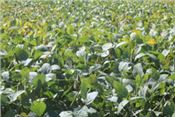UK Offers Considerations For Grazing, Harvesting Drought-Stressed Soybeans

A drought hit the state during a critical development time for late-planted and double-crop soybeans.
Photo courtesy of Chris Teutsch, UK extension forage specialist.
PRINCETON, KY.
Producers can graze and harvest drought-stressed soybeans for baleage and hay but need to make careful considerations before doing so, said Chris Teutsch, extension forage specialist with the University of Kentucky College of Agriculture, Food and Environment.
A drought hit Kentucky during critical development time for late-planted and double-crop soybeans. This may have resulted in little to no grain development and a low yielding crop. The drought has also impacted hay production across the state, leaving livestock producers looking for forages as winter approaches.
“While using soybeans as forage may seem like a way to fulfill two needs, producers should make sure they are doing the right thing for their animals and themselves before grazing or harvesting soybeans,” said Teutsch, a faculty member with the UK Grain and Forage Center of Excellence.
Before using the soybeans for anything other than grain production, producers should consult their crop insurance agent and local representative with the U.S. Department of Agriculture Farm Service Agency. These individuals can tell a producer whether using the soybeans for forage will result in a loss of indemnity or disaster relief payments. Certain herbicides used on soybeans do not allow the soybean plants to be consumed by livestock. Producers should always check the herbicide labels to confirm that harvesting treated soybeans is allowable.
If producers plan to harvest or graze drought-stressed soybeans, they should do so soon before the leaves yellow or drop.
“Since, drought-stressed soybeans contain very little grain, it is essential to harvest or graze soybeans when the leaves are still green,” Teutsch said. “If harvested prior to leaf loss, drought-stressed soybeans with no grain development can have 12 to 15 percent crude protein and 55 percent to 60 percent total digestible nutrients. Producers can expect yields of 1.5 to 2 tons of dry matter per acre.”
Strip grazing is the most effective way for producers to graze livestock on drought-stressed soybeans, as it increases forage utilization and reduces losses from livestock trampling the crop. Producers can use temporary electric fencing to strip graze, but they should make sure animals are trained to electric fencing before grazing begins.
Producers can also harvest the soybeans for baleage or hay. To reduce leaf loss, producers are encouraged to harvest drought-stressed soybeans as baleage. Harvesting as dry hay significantly increases the chances of leaf shatter. Those using the soybeans for baleage should wilt the crop from 55 percent to 65 percent moisture to ensure rapid and complete fermentation. Dense bales store the best. Producers should wrap bales with high quality silage wrap immediately after baling and allow the bales six to eight weeks to ferment properly before feeding.
Producers using soybeans for hay should bale it when the crop reaches between 16 percent and 18 percent moisture to prevent mold growth. Soybeans should not be raked or baled when it is too dry, as it will cause considerable leaf loss and reduce forage quality.
Producers should test soybean baleage and forage prior to feeding it to livestock, because excessive leaf loss during harvesting, heating or poor fermentation can alter its nutritional content. Livestock should have access to fresh, clean water and a mineral supplement at all times when consuming baleage or hay. ∆